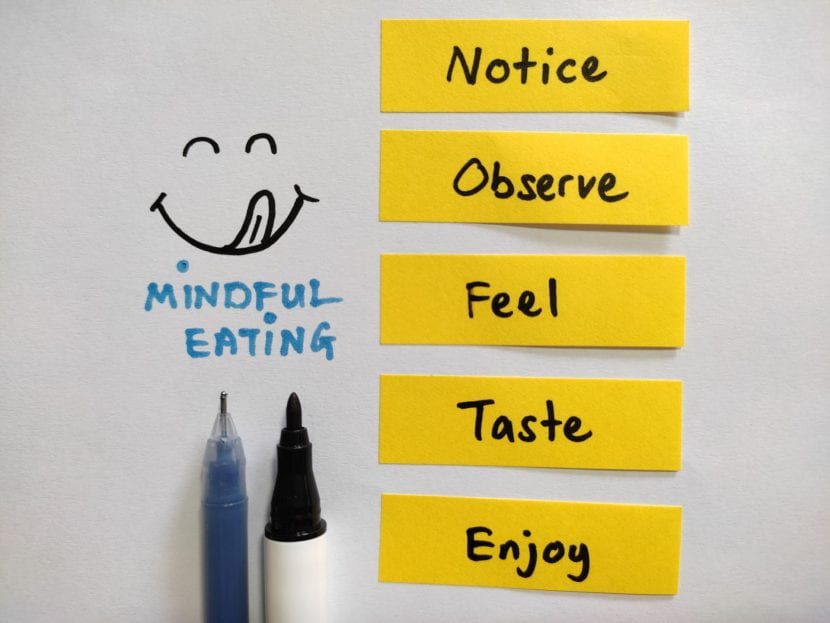With a jam-packed schedule, it can be a challenge to find the time to prepare and sit down for a nutritious meal. Sometimes, food can even feel like a chore! However, integrating mindfulness into all aspects of your food-related routine can help you and your family feel more joy around mealtimes.
What is mindfulness?
According to the Miriam Webster Dictionary, mindfulness is “the practice of maintaining a nonjudgmental state of heightened or complete awareness of one’s thoughts, emotions, or experiences on a moment-to-moment basis” (2022). Mindfulness is a perspective and sense of awareness that can be applied to any aspect of your life, bringing your focus to your body, mind, environment and more.
Steps to Eat Mindfully
When we bring mindfulness to our experience with food, we are taking the time to see food as an opportunity to nourish our minds and bodies. Mindfulness can come before we eat as we choose what to purchase, what to prepare, how to prepare it, how and when we would like to eat it and perhaps who we would like to enjoy the meal with. Research has found that mindfulness may “lead to greater psychological wellbeing, increased pleasure when eating, and body satisfaction. Combining behavioral strategies such as mindfulness training with nutrition knowledge can lead to healthful food choices that reduce the risk of chronic diseases, promote more enjoyable meal experiences, and support a healthy body image” (The Nutrition Source, Harvard University, 2022). Let’s look at what mindfulness can be like during each stage:
Meal Planning
Take some time to reflect on the foods you and your family had recently. What ones did you enjoy most? What flavors or items within the meal were most satisfying? Are there any flavors or foods that you have been craving or anything you would like to try? While working around what you have on hand, your budget, the products on sale or in season, and what your schedule looks like, consider adding these foods and flavors into your plan for the day, week or month. When purchasing food, you can be mindful of your state of hunger, what you are most drawn to and even reflect on the journey each item takes to make it your table.
Meal Preparation
Some meals take more time to prepare than others and in being mindful of our time and energy, we can be strategic about the type of food experiences we are having. Preparing food can be a chance to learn or practice new skills in the kitchen, alone or with friends or family members. Some find that cooking can be therapeutic, with the flavors, aroma and sensory experience giving them some space from other things happening in their life. Involving children in the process of cooking and plating meals can also increase their likelihood of giving it a try during mealtime, aware of their role and creativity in putting together the final product. This can also be a time to explore different ways of serving a dish, including the size of the dishware and perhaps opting to have a self-serve or family style meal over pre-portioning food to promote individual choice over how much to eat.
Mealtime
- The setting and amount of time we have to eat can influence our enjoyment of our food. Try to make mealtime media-free by sitting at the table together. This encourages everyone to take a moment to slow down, socialize with one another and share their thoughts and sensations around the meal. When eating out, remember you can always take food home for later.
Here are some small steps to eat your meal mindfully:
- Appreciating your Food- Find gratitude by considering where your food came from and all the energy that went into bringing it to your plate and belly.
- Eating Slow- Take a moment to savor the flavor! Why rush a good thing?
- Engaging Your Senses- What does your food really taste like? Is it salty, sweet or savory? What are the textures like on their own and together? What colors make up your plate?
- Noticing the Effects of Your Food- Shift your attention to your body. How does it feel differently while eating this food? Can you feel the spice on your tongue?
- Taking Small Bites- Keep an eye on your hunger by taking small bites and checking in on if you’d like to eat more or to be finished. If you’re still hungry, what are you craving?
Ways to Help Others Eat Mindfully
- Agency- give your family or guests the option to choose whether to eat or not and how much to eat, allowing them the opportunity to check in with their hunger.
- Reduce Stress- food should be fun and help make us feel good. Get creative with it!
- Bring what and if you can. Make food preparation voluntary for guests rather than required.
- Courtesy- ask about dietary restrictions and preferences ahead of time.
- Safety- label foods with ingredients to help those with allergies or restrictions.
- Goodie Bags! Have guests bring food storage containers or provide them yourself for leftovers or meals to-go.
- Togetherness- involve each other in the food planning and food-making process.
- Set phones and other technology aside at the table for quality time.
- Sharing- put a name to food ingredients or flavors to encourage food exploration.
- Be a role model! We influence each other’s thoughts, behaviors, and practices around food. Stay open-minded to learning from others and sharing your approach.
How can you integrate mindfulness into your family meals?
Resources:
- School of Public Health, Harvard University. (2022, March 11). Mindful eating. The Nutrition Source. Retrieved December 15, 2022, from https://www.hsph.harvard.edu/nutritionsource/mindful-eating/
- Merriam-Webster. (n.d.). Mindfulness. In Merriam-Webster.com dictionary. Retrieved December 15, 2022, from https://www.merriam-webster.com/dictionary/mindfulness

